battery YAMAHA XL 1200 2001 Owners Manual
[x] Cancel search | Manufacturer: YAMAHA, Model Year: 2001, Model line: XL 1200, Model: YAMAHA XL 1200 2001Pages: 131, PDF Size: 8.12 MB
Page 25 of 131
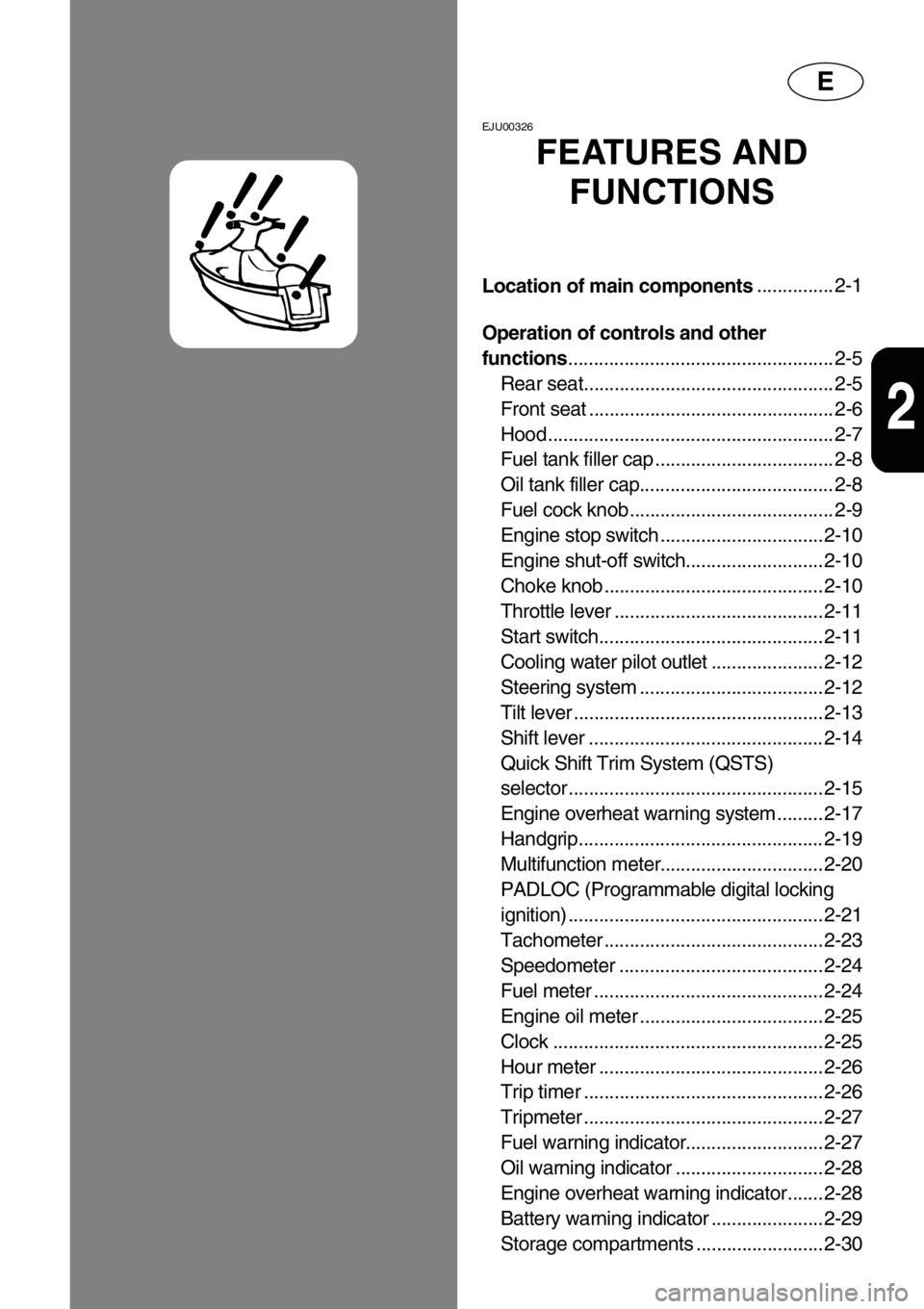
E
2
EJU00326
FEATURES AND
FUNCTIONS
Location of main components............... 2-1
Operation of controls and other
functions.................................................... 2-5
Rear seat................................................. 2-5
Front seat ................................................ 2-6
Hood ........................................................ 2-7
Fuel tank filler cap ................................... 2-8
Oil tank filler cap...................................... 2-8
Fuel cock knob........................................ 2-9
Engine stop switch ................................ 2-10
Engine shut-off switch........................... 2-10
Choke knob ........................................... 2-10
Throttle lever ......................................... 2-11
Start switch............................................ 2-11
Cooling water pilot outlet ...................... 2-12
Steering system .................................... 2-12
Tilt lever ................................................. 2-13
Shift lever .............................................. 2-14
Quick Shift Trim System (QSTS)
selector .................................................. 2-15
Engine overheat warning system ......... 2-17
Handgrip................................................ 2-19
Multifunction meter................................ 2-20
PADLOC (Programmable digital locking
ignition) .................................................. 2-21
Tachometer ........................................... 2-23
Speedometer ........................................ 2-24
Fuel meter ............................................. 2-24
Engine oil meter .................................... 2-25
Clock ..................................................... 2-25
Hour meter ............................................ 2-26
Trip timer ............................................... 2-26
Tripmeter ............................................... 2-27
Fuel warning indicator........................... 2-27
Oil warning indicator ............................. 2-28
Engine overheat warning indicator....... 2-28
Battery warning indicator ...................... 2-29
Storage compartments ......................... 2-30
Page 29 of 131
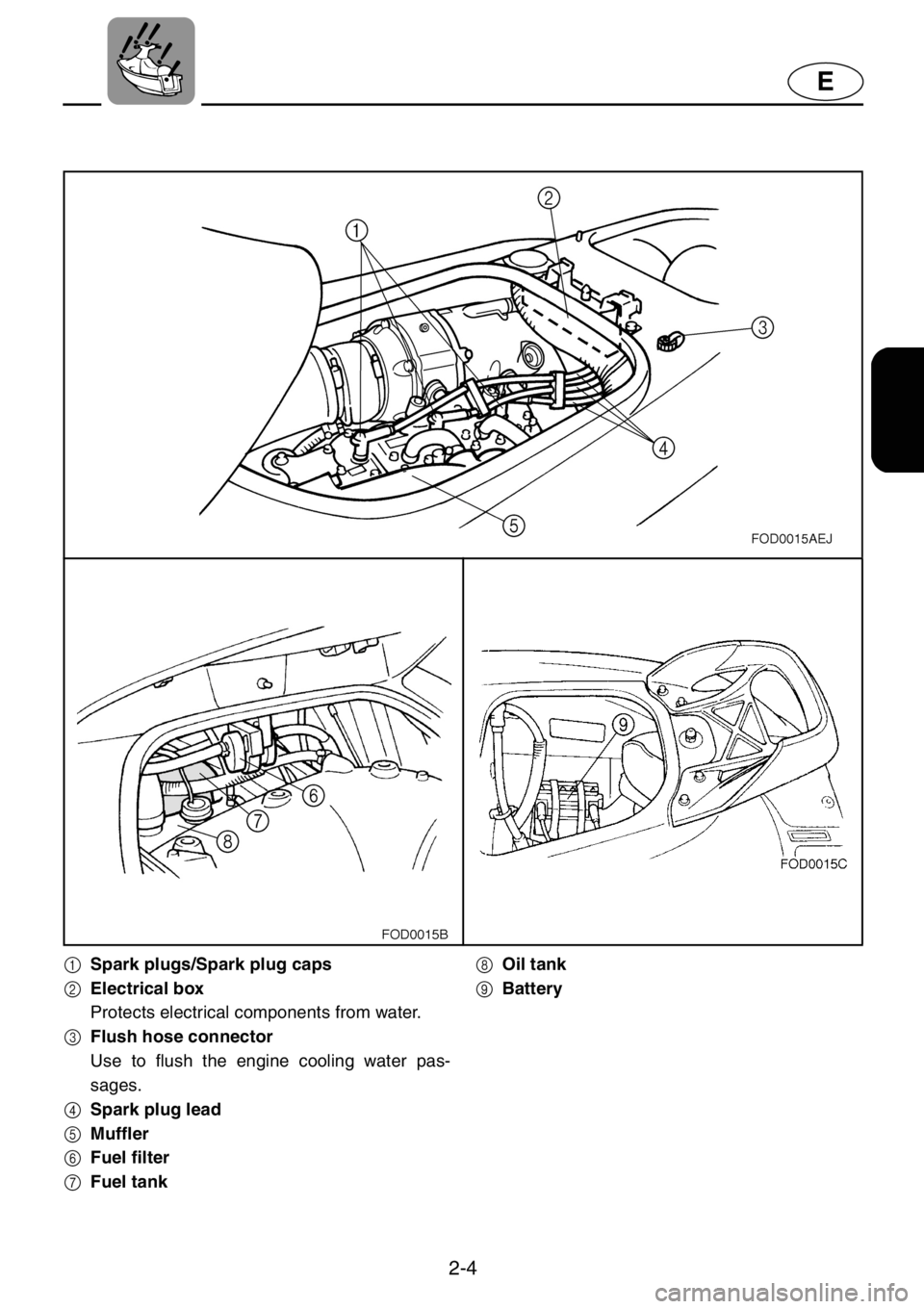
2-4
E
1Spark plugs/Spark plug caps
2Electrical box
Protects electrical components from water.
3Flush hose connector
Use to flush the engine cooling water pas-
sages.
4Spark plug lead
5Muffler
6Fuel filter
7Fuel tank8Oil tank
9Battery
Page 45 of 131
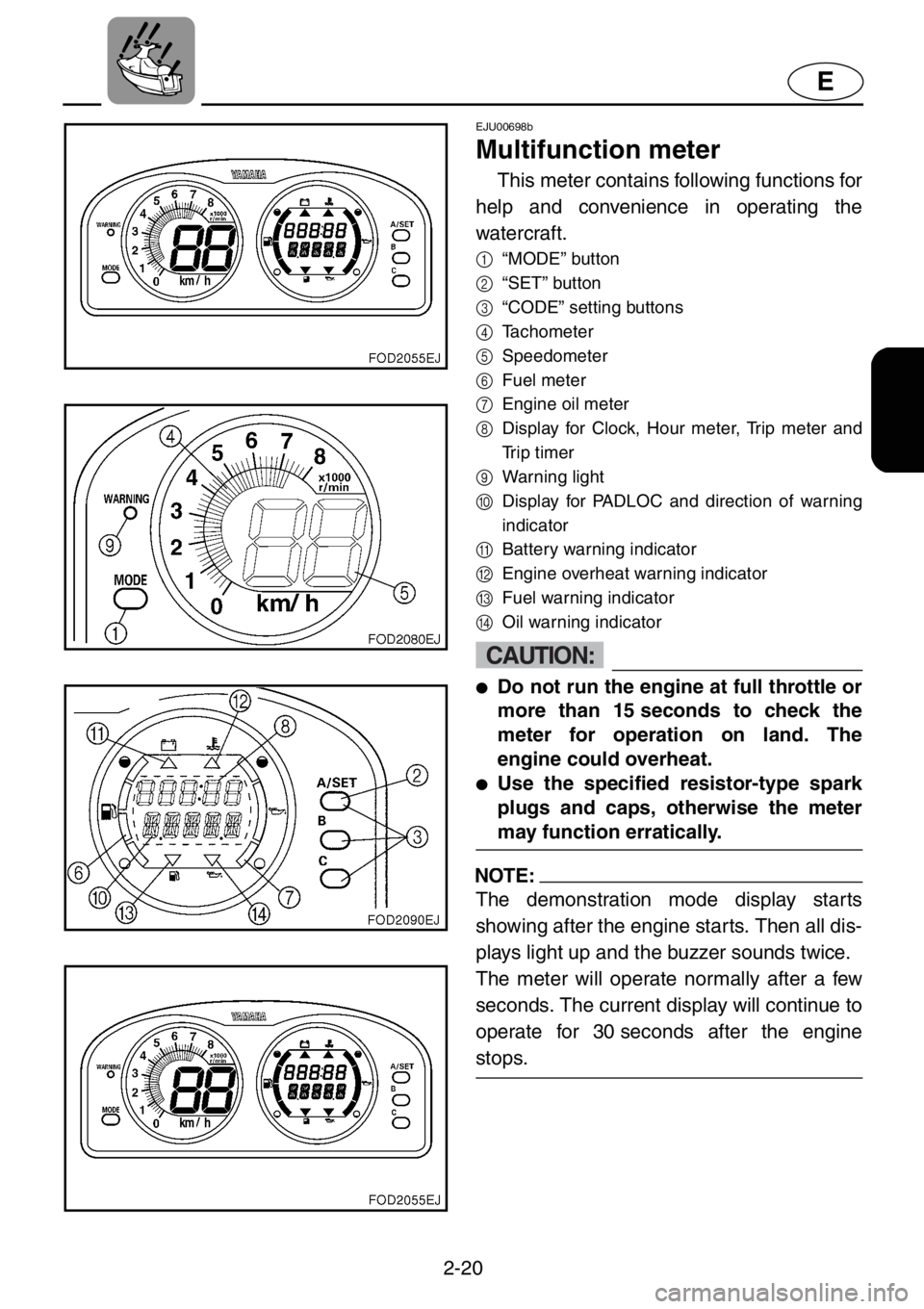
2-20
E
EJU00698b
Multifunction meter
This meter contains following functions for
help and convenience in operating the
watercraft.
1
“MODE” button
2
“SET” button
3
“CODE” setting buttons
4
Tachometer
5
Speedometer
6
Fuel meter
7
Engine oil meter
8
Display for Clock, Hour meter, Trip meter and
Trip timer
9
Warning light
0
Display for PADLOC and direction of warning
indicator
A
Battery warning indicator
B
Engine overheat warning indicator
C
Fuel warning indicator
D
Oil warning indicator
CAUTION:
●Do not run the engine at full throttle or
more than 15 seconds to check the
meter for operation on land. The
engine could overheat.
●Use the specified resistor-type spark
plugs and caps, otherwise the meter
may function erratically.
NOTE:
The demonstration mode display starts
showing after the engine starts. Then all dis-
plays light up and the buzzer sounds twice.
The meter will operate normally after a few
seconds. The current display will continue to
operate for 30 seconds after the engine
stops.
Page 47 of 131
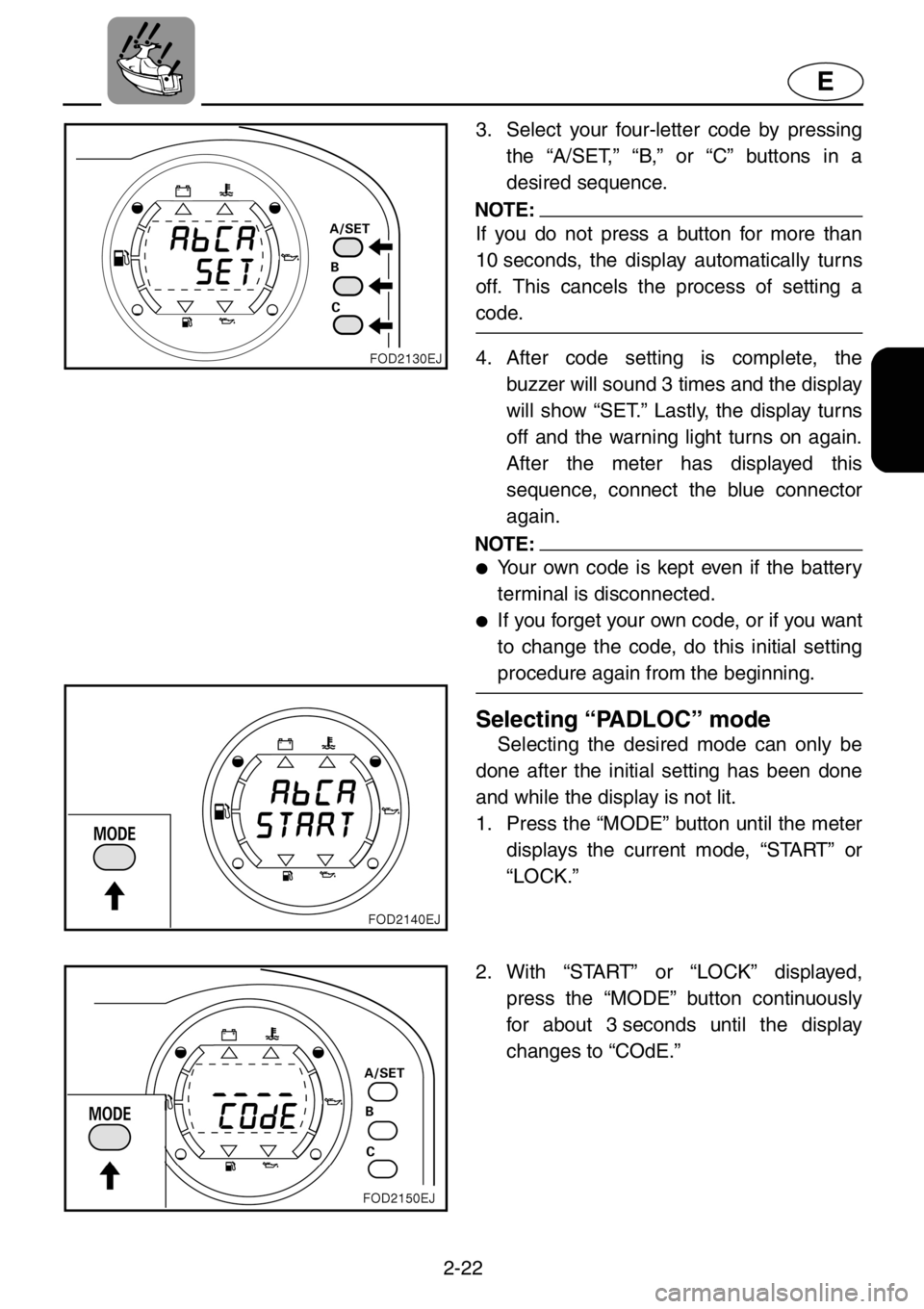
2-22
E
3. Select your four-letter code by pressing
the “A/SET,” “B,” or “C” buttons in a
desired sequence.
NOTE:
If you do not press a button for more than
10 seconds, the display automatically turns
off. This cancels the process of setting a
code.
4. After code setting is complete, the
buzzer will sound 3 times and the display
will show “SET.” Lastly, the display turns
off and the warning light turns on again.
After the meter has displayed this
sequence, connect the blue connector
again.
NOTE:
●Your own code is kept even if the battery
terminal is disconnected.
●If you forget your own code, or if you want
to change the code, do this initial setting
procedure again from the beginning.
Selecting “PADLOC” mode
Selecting the desired mode can only be
done after the initial setting has been done
and while the display is not lit.
1. Press the “MODE” button until the meter
displays the current mode, “START” or
“LOCK.”
2. With “START” or “LOCK” displayed,
press the “MODE” button continuously
for about 3 seconds until the display
changes to “COdE.”
Page 51 of 131
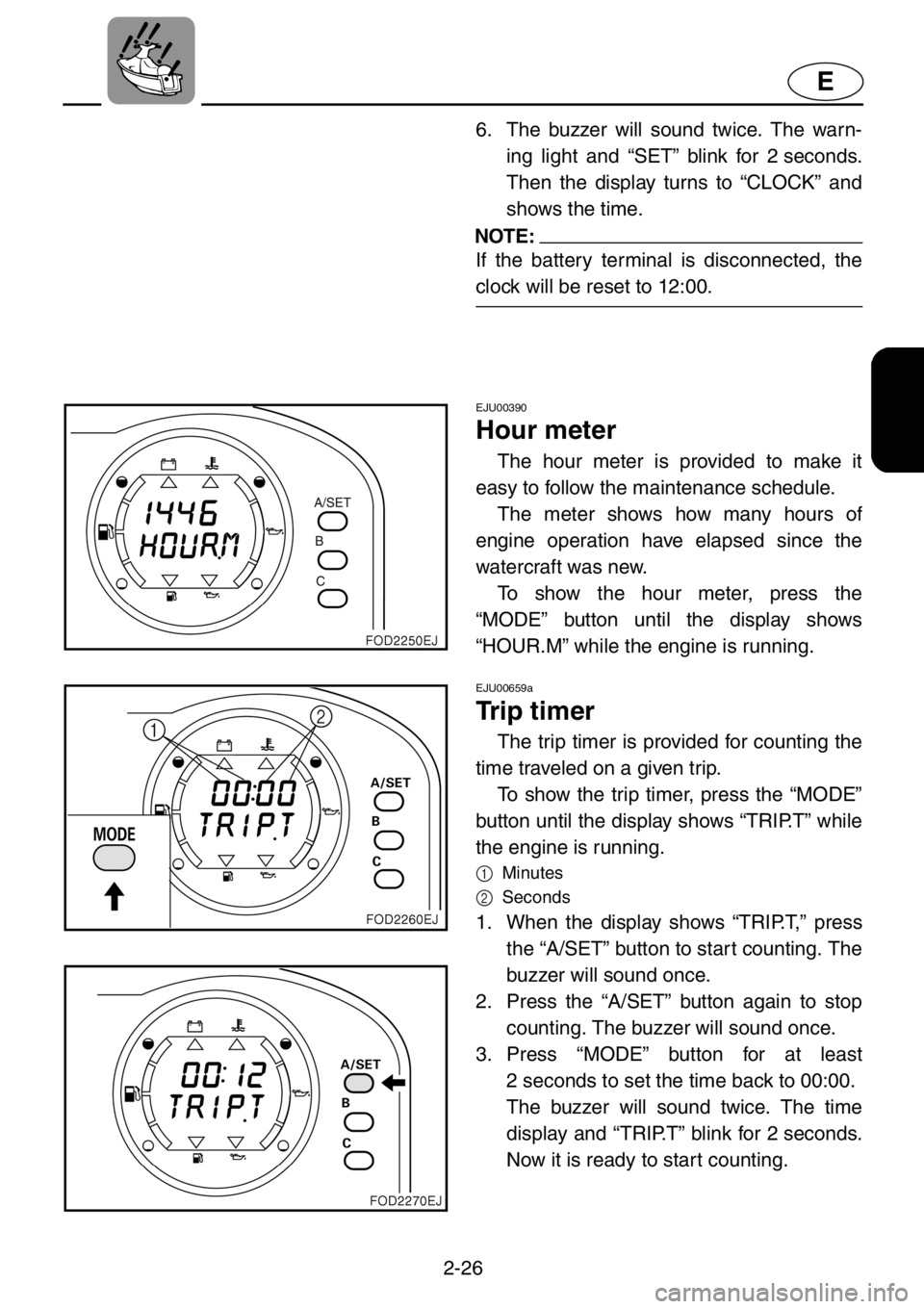
2-26
E
6. The buzzer will sound twice. The warn-
ing light and “SET” blink for 2 seconds.
Then the display turns to “CLOCK” and
shows the time.
NOTE:
If the battery terminal is disconnected, the
clock will be reset to 12:00.
EJU00390
Hour meter
The hour meter is provided to make it
easy to follow the maintenance schedule.
The meter shows how many hours of
engine operation have elapsed since the
watercraft was new.
To show the hour meter, press the
“MODE” button until the display shows
“HOUR.M” while the engine is running.
EJU00659a
Trip timer
The trip timer is provided for counting the
time traveled on a given trip.
To show the trip timer, press the “MODE”
button until the display shows “TRIP.T” while
the engine is running.
1
Minutes
2
Seconds
1. When the display shows “TRIP.T,” press
the “A/SET” button to start counting. The
buzzer will sound once.
2. Press the “A/SET” button again to stop
counting. The buzzer will sound once.
3. Press “MODE” button for at least
2 seconds to set the time back to 00:00.
The buzzer will sound twice. The time
display and “TRIP.T” blink for 2 seconds.
Now it is ready to start counting.
Page 53 of 131
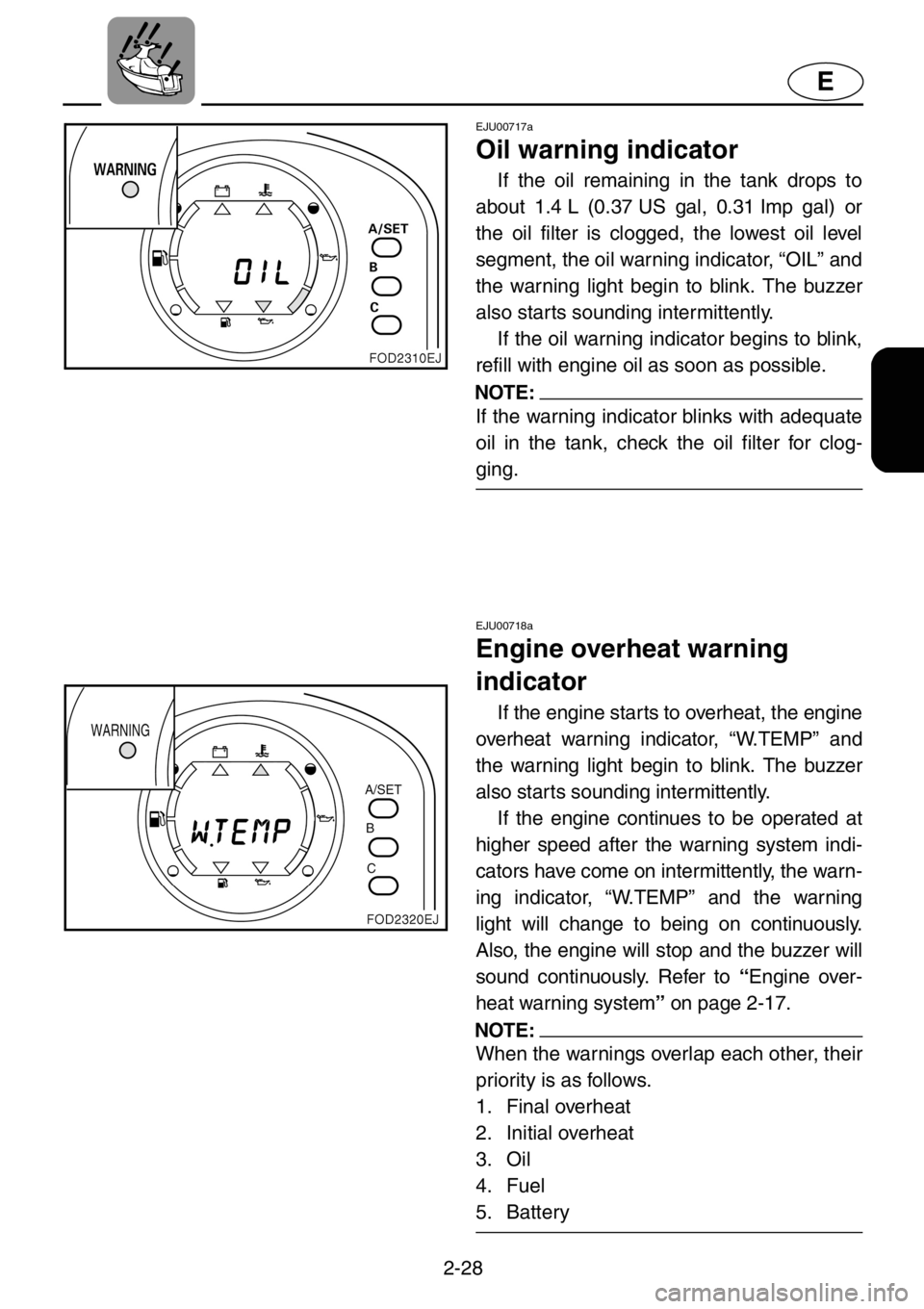
2-28
E
EJU00717a
Oil warning indicator
If the oil remaining in the tank drops to
about 1.4 L (0.37 US gal, 0.31 Imp gal) or
the oil filter is clogged, the lowest oil level
segment, the oil warning indicator, “OIL” and
the warning light begin to blink. The buzzer
also starts sounding intermittently.
If the oil warning indicator begins to blink,
refill with engine oil as soon as possible.
NOTE:
If the warning indicator blinks with adequate
oil in the tank, check the oil filter for clog-
ging.
EJU00718a
Engine overheat warning
indicator
If the engine starts to overheat, the engine
overheat warning indicator, “W.TEMP” and
the warning light begin to blink. The buzzer
also starts sounding intermittently.
If the engine continues to be operated at
higher speed after the warning system indi-
cators have come on intermittently, the warn-
ing indicator, “W.TEMP” and the warning
light will change to being on continuously.
Also, the engine will stop and the buzzer will
sound continuously. Refer to “Engine over-
heat warning system” on page 2-17.
NOTE:
When the warnings overlap each other, their
priority is as follows.
1. Final overheat
2. Initial overheat
3. Oil
4. Fuel
5. Battery
Page 54 of 131
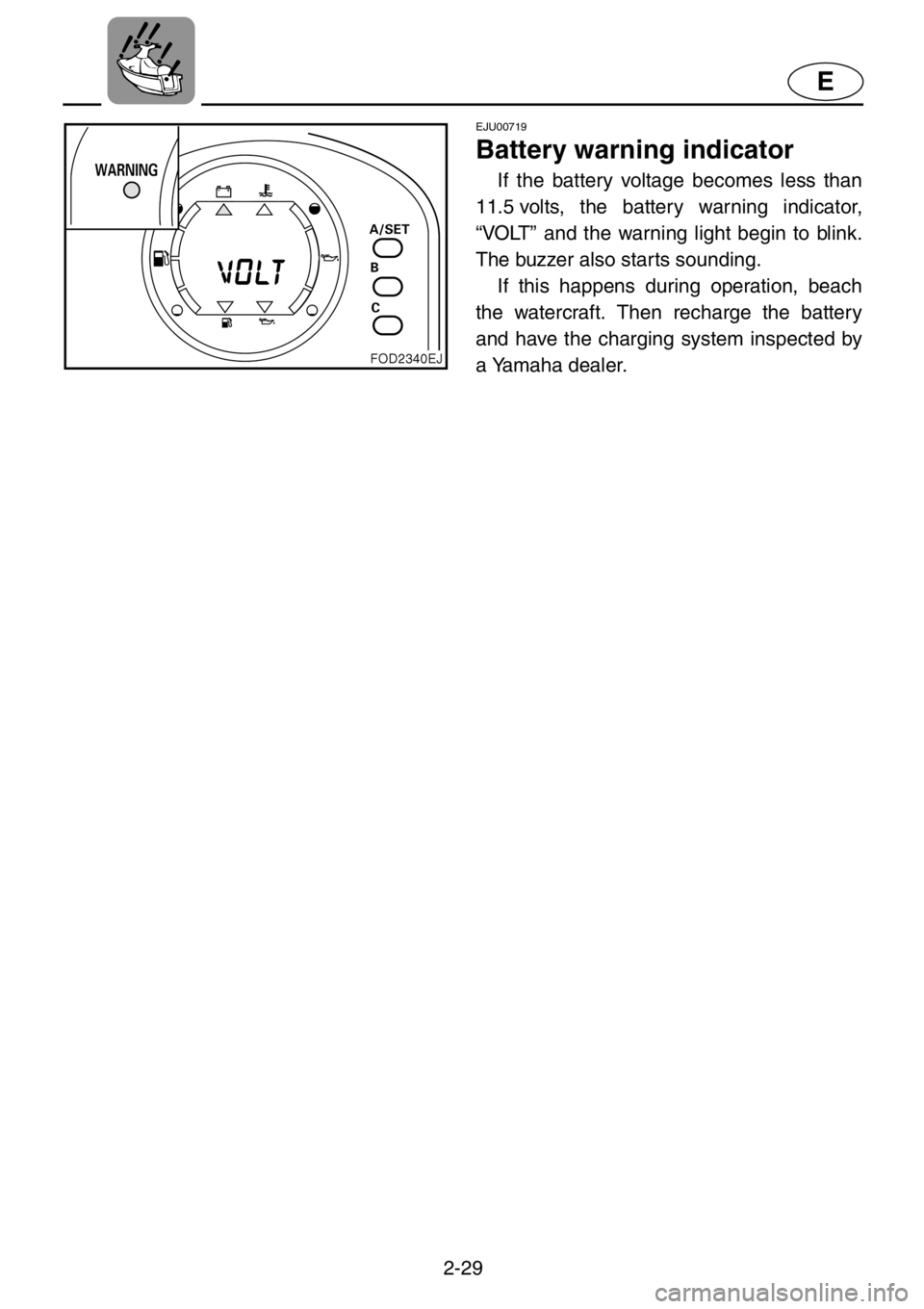
2-29
E
EJU00719
Battery warning indicator
If the battery voltage becomes less than
11.5 volts, the battery warning indicator,
“VOLT” and the warning light begin to blink.
The buzzer also starts sounding.
If this happens during operation, beach
the watercraft. Then recharge the battery
and have the charging system inspected by
a Yamaha dealer.
Page 62 of 131
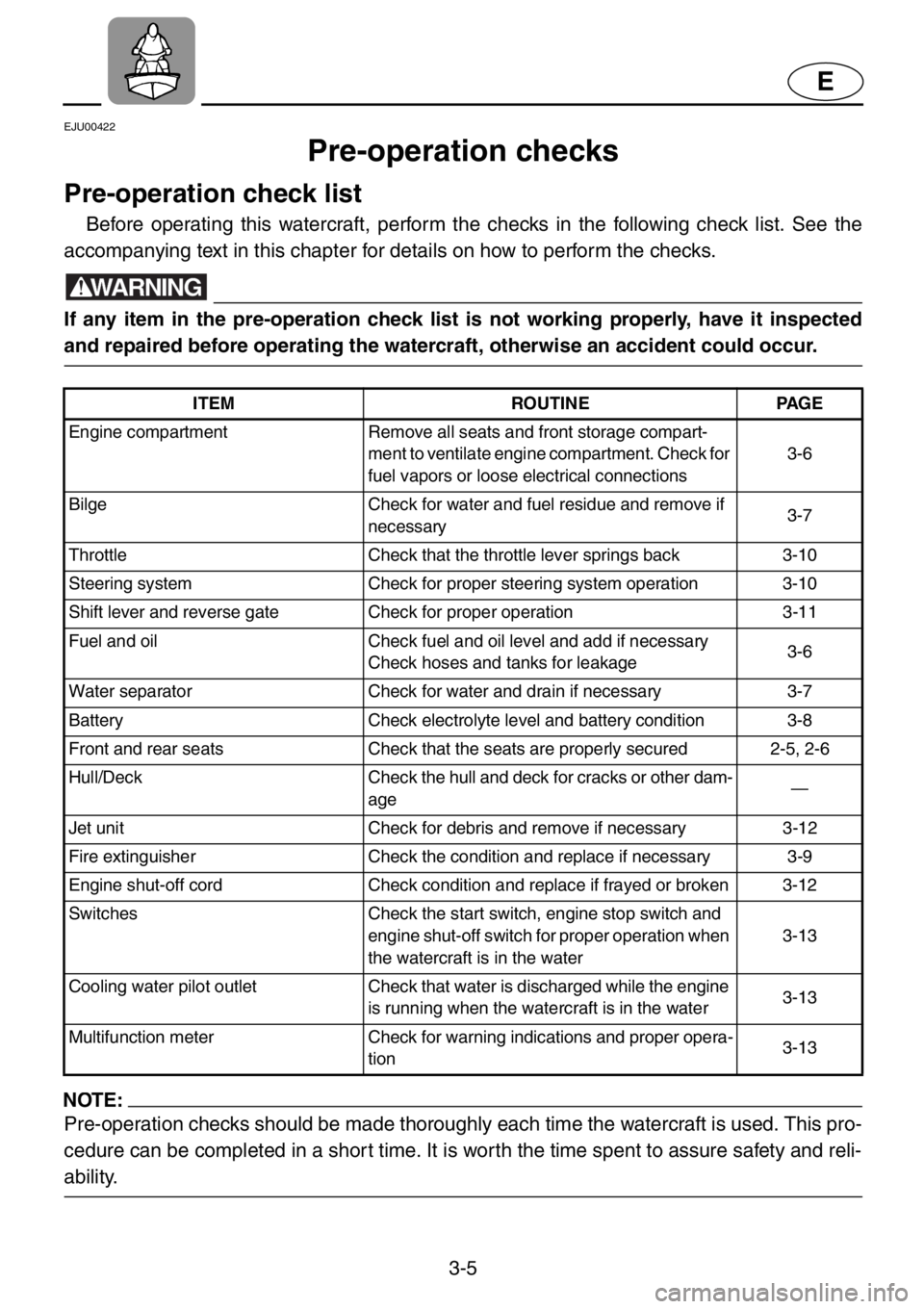
3-5
E
EJU00422
Pre-operation checks
Pre-operation check list
Before operating this watercraft, perform the checks in the following check list. See the
accompanying text in this chapter for details on how to perform the checks.
WARNING
If any item in the pre-operation check list is not working properly, have it inspected
and repaired before operating the watercraft, otherwise an accident could occur.
NOTE:
Pre-operation checks should be made thoroughly each time the watercraft is used. This pro-
cedure can be completed in a short time. It is worth the time spent to assure safety and reli-
ability.
ITEM ROUTINE PAGE
Engine compartment Remove all seats and front storage compart-
ment to ventilate engine compartment. Check for
fuel vapors or loose electrical connections3-6
Bilge Check for water and fuel residue and remove if
necessary3-7
Throttle Check that the throttle lever springs back 3-10
Steering system Check for proper steering system operation 3-10
Shift lever and reverse gate Check for proper operation 3-11
Fuel and oil Check fuel and oil level and add if necessary
Check hoses and tanks for leakage3-6
Water separator Check for water and drain if necessary 3-7
Battery Check electrolyte level and battery condition 3-8
Front and rear seats Check that the seats are properly secured 2-5, 2-6
Hull/Deck Check the hull and deck for cracks or other dam-
age—
Jet unit Check for debris and remove if necessary 3-12
Fire extinguisher Check the condition and replace if necessary 3-9
Engine shut-off cord Check condition and replace if frayed or broken 3-12
Switches Check the start switch, engine stop switch and
engine shut-off switch for proper operation when
the watercraft is in the water3-13
Cooling water pilot outlet Check that water is discharged while the engine
is running when the watercraft is in the water3-13
Multifunction meter Check for warning indications and proper opera-
tion3-13
Page 65 of 131
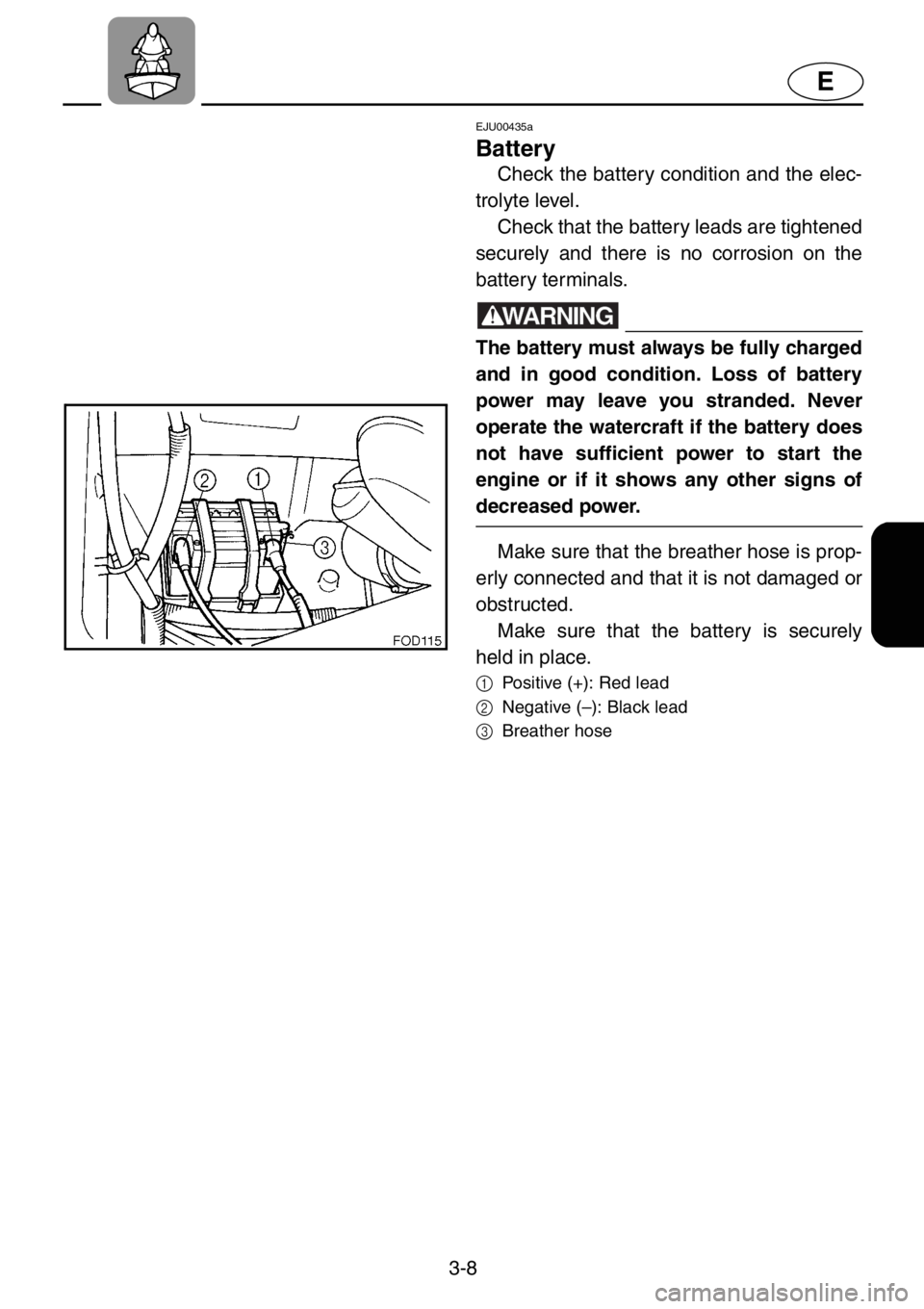
3-8
E
EJU00435a
Battery
Check the battery condition and the elec-
trolyte level.
Check that the battery leads are tightened
securely and there is no corrosion on the
battery terminals.
WARNING
The battery must always be fully charged
and in good condition. Loss of battery
power may leave you stranded. Never
operate the watercraft if the battery does
not have sufficient power to start the
engine or if it shows any other signs of
decreased power.
Make sure that the breather hose is prop-
erly connected and that it is not damaged or
obstructed.
Make sure that the battery is securely
held in place.
1
Positive (+): Red lead
2
Negative (–): Black lead
3
Breather hose
Page 75 of 131
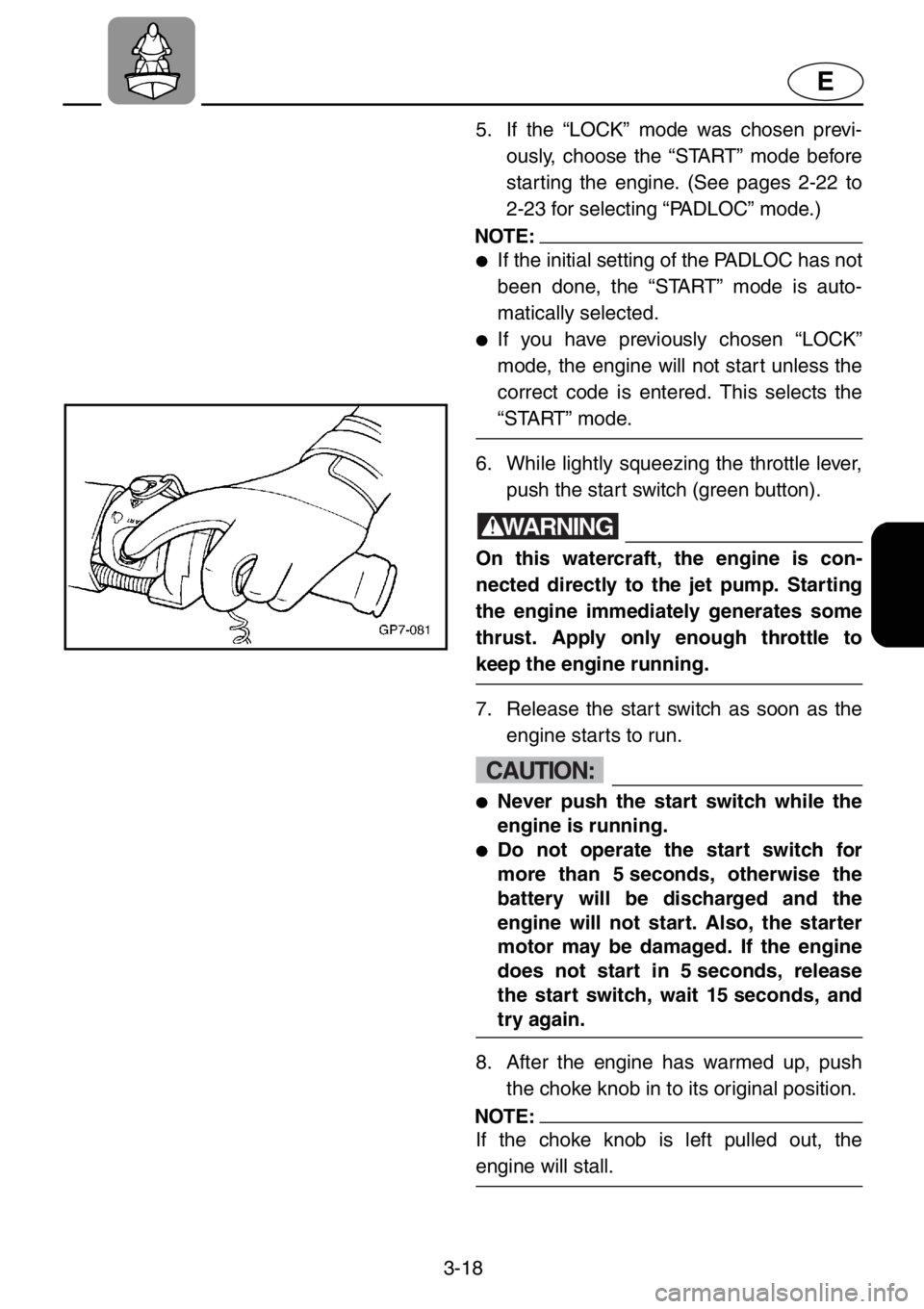
3-18
E
5. If the “LOCK” mode was chosen previ-
ously, choose the “START” mode before
starting the engine. (See pages 2-22 to
2-23 for selecting “PADLOC” mode.)
NOTE:
●If the initial setting of the PADLOC has not
been done, the “START” mode is auto-
matically selected.
●If you have previously chosen “LOCK”
mode, the engine will not start unless the
correct code is entered. This selects the
“START” mode.
6. While lightly squeezing the throttle lever,
push the start switch (green button).
WARNING
On this watercraft, the engine is con-
nected directly to the jet pump. Starting
the engine immediately generates some
thrust. Apply only enough throttle to
keep the engine running.
7. Release the start switch as soon as the
engine starts to run.
CAUTION:
●Never push the start switch while the
engine is running.
●Do not operate the start switch for
more than 5 seconds, otherwise the
battery will be discharged and the
engine will not start. Also, the starter
motor may be damaged. If the engine
does not start in 5 seconds, release
the start switch, wait 15 seconds, and
try again.
8. After the engine has warmed up, push
the choke knob in to its original position.
NOTE:
If the choke knob is left pulled out, the
engine will stall.